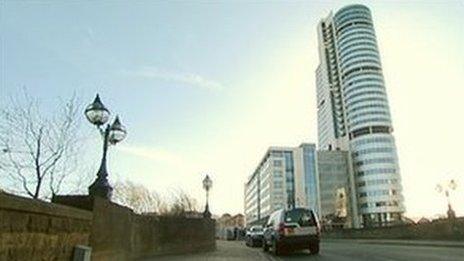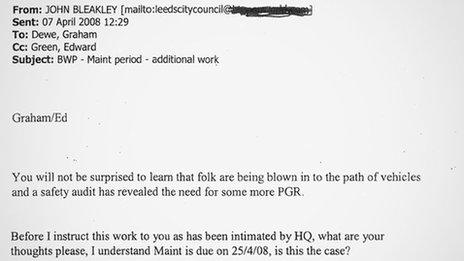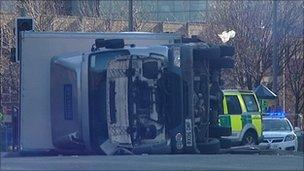Bridgewater Place: Council official warned of wind fears
- Published

The 367ft (112m) high building was built in 2007
Council officials knew high winds caused by a skyscraper in Leeds were dangerous before the building was completed, BBC News has learned.
An email sent in January 2007 by council officer John Bleakley warned of "unprecedented" winds three months before Bridgewater Place was finished.
Warning emails were also sent to the council between 2007 and 2011 before a man died when winds blew a lorry over.
The council said it was up to the building's owners to find a solution.
The building's owners, CPPI Bridgewater Place, were unavailable for comment at the time of publication.
Dr Edward Slaney was crushed by a lorry as high winds blew around the 32-storey Bridgewater Place in March 2011.
Before his death emails obtained by BBC Radio Leeds show concerns were raised by Mr Bleakley, now Group Engineer (Operations) at Leeds City Council, a law firm and other individuals.

Mr Bleakley wrote to colleagues admitting there were wind problems and warning of the council "being vulnerable".
In one email sent to colleagues on 11 January 2007 he said: "The temp signal (pole on barrel) at the junction of Water Lane and Victoria Rd has blown down for the nth time a short while ago.
"The winds at this junction are whipped up by the new building and are unprecedented in my experience.
"The temp poles in barrels are designed by LCC [Leeds City Council], if one was to fall on a ped, [pedestrian] the council would be vulnerable."
In April 2008 Mr Bleakley again wrote to colleagues and said: "You will not be surprised to learn that folk are being blown into the path of vehicles and a safety audit has revealed the need for some more PGR" (portable guard rails).
One man wrote in an email to the council in February 2008 "During the recent extreme weather one of my friends was actually blown from the pavement into oncoming traffic and I think it's only a matter of time before there's an accident."
That letter was forwarded to the then leader of the council Andrew Carter asking if the authority was "aware of the potential dangers of the wind".
'Picked off pavement'
In March 2008, the law firm Eversheds which is based at Bridgewater Place, wrote to the council "increasingly concerned about the safety of our employees and other pedestrians using the roads and footpaths in the vicinity of Bridgewater Place".
Eversheds went on to highlight the case of an employee "picked up off the pavement" and suffering serious injuries after being blown across the road.
"It is entirely good fortune that she was not hit by traffic travelling through this extremely busy junction," the firm told the council.
Another email sent on 1 April 2008 told council officers "You need to get some people down to Bridgewater Place this lunchtime to see how the wind is blowing people around.
"There needs to be some safety barriers put around traffic lights on the HBOS [Halifax Bank of Scotland] side of the building as I've just seen a woman practically blown across the road."

Dr Edward Slaney died when a lorry was blown over in March 2011
In February 2011 council officer Mike Darwin, the head of Highways Development Services, told a colleague in an email "If we react to these winds in this area we would have to place guard rails throughout the city, which would not be appropriate."
In a statement, Leeds City Council said: "The wind-generated issues around Bridgewater Place continue to be the responsibility of the building's owners to resolve.
"Ever since complaints began to be received, Leeds City Council has sought to ensure a comprehensive solution to the problem is identified and implemented.
"This has centred on the owners finding a permanent solution covering the immediate area around Bridgewater Place and also the public highway.
"Their correspondence at that time gave us confidence this matter was being treated seriously and urgently."
The council said that after site investigations and to address concerns about the risk of pedestrians being blown into the road concrete barriers and guard railings were installed in April and July 2008.
The authority said 180 metres of guardrail had been placed around the building.
It said work to identify a "comprehensive solution" had involved "highly specialist work and world-renowned consultants".
The council added: "Leeds City Council has jointly funded this work to ensure the appropriate solution is brought forward as soon as possible.
"Ultimately, the latter has been elusive because of the complexity of the work involved.
"In summary, Leeds City Council has expended significant resources to find a comprehensive solution to this problem which ultimately is the responsibility of the owners of Bridgewater Place."
- Published30 September 2013
- Published29 August 2013
- Published24 June 2013
- Published31 May 2013
- Published1 March 2013
- Published15 February 2013
- Published10 February 2012
- Published9 February 2012
- Published11 March 2011